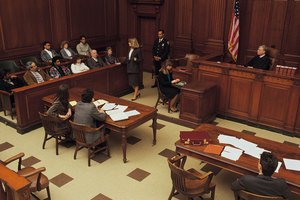What Happens at Restraining Order Hearings?
By Mike Broemmel
Updated December 11, 2018

Comstock/Stockbyte/Getty Images
A restraining order, sometimes referred to as a protection from abuse order, is designed to protect a person who suffered from abuse at the hands of another person, according to the American Bar Association Section of Family Law. A common situation in which this type of order is issued is in a domestic relationship, including between a wife and husband. After a temporary restraining order issues, a hearing is scheduled.
Function
The primary function of a restraining order hearing is to allow a judge the chance to hear both sides of the story regarding the facts and circumstances giving rise to the temporary order, according to HG.org. Both the person who seeks the restraining order, and the individual who is the subject of the decree, present evidence and argument supporting their respective positions on the appropriateness of the decree.
Time Frame
A restraining order hearing typically is conducted between one to four weeks after the temporary order issues, according to FindLaw. Each state maintains individual laws on the timing of a restraining order hearing. The key element to scheduling the hearing is service of the temporary restraining order by the sheriff on the defendant as well as notifying that individual of the date and time of the hearing.
Effects
Three possible consequences arise out of a restraining order hearing. First, the parties mutually agree to the restraining order and the judge accepts the agreement. Second, the judge concludes that insufficient evidence exists to support a restraining order and dismisses the case. Finally, the court agrees that sufficient evidence exists and issues a permanent restraining order.
Features
A restraining order hearing has some of the trappings of a trial, without a jury. Both parties appear before a judge and typically are sworn in so that they can provide testimony under oath. If attorneys represent the parties, they make arguments before the court. Otherwise, the parties must make presentations for themselves. A judge rules on evidence in the same manner used in a trial.
Misconceptions
A common misconception associated with a restraining order hearing centers on the decree issued by the judge at the end of the proceeding. Although it is called a "permanent" restraining order, the decree normally remains in force for one year. At that time, the parties return to court--if they so desire--to seek a continuance of the order or argue in favor of expiration.
References
Resources
Writer Bio
Mike Broemmel began writing in 1982. He is an author/lecturer with two novels on the market internationally, "The Shadow Cast" and "The Miller Moth." Broemmel served on the staff of the White House Office of Media Relations. He holds a Bachelor of Arts in journalism and political science from Benedictine College and a Juris Doctorate from Washburn University. He also attended Brunel University, London.